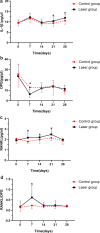Clinical research: low-level laser therapy in accelerating orthodontic tooth movement
- PMID: 34182967
- PMCID: PMC8237464
- DOI: 10.1186/s12903-021-01684-z
Clinical research: low-level laser therapy in accelerating orthodontic tooth movement
Abstract
Background: The present study aimed to investigate the effects of low-level laser therapy (LLLT) on orthodontic tooth movement and its correlation with the levels of interleukin-1β (IL-1β), receptor activator of nuclear factor kappa B ligand (RANKL) and osteoprotegerin (OPG) in gingival crevicular fluid (GCF).
Methods: This split-mouth design study included 12 patients scheduled for the extraction of both upper first premolars. Patients were randomly selected for experimental group that received left- or right-side radiation with a diode laser (810 nm wavelength, 100 mW power output, 6.29 J/cm2 energy density). Laser treatment was applied on days 0, 7, 14, and 21, after loading the canine retraction forces. GCF concentrations of IL-1β, RANKL, and OPG were analyzed. The upper arch of each patient was scanned with an intraoral scanner to assess tooth movement.
Results: The cumulative tooth movement over 28 days was significantly higher in the laser group than in the control group. We observed significant reductions in OPG levels and increases in IL-1β and RANKL levels in GCF samples on the experimental sides.
Conclusion: With the parameter settings used in this study, LLLT could, to some extent, lead to changes in bone metabolism, which could accelerate orthodontic tooth movement.
Trial registration: Chinese Clinical Trial Registry, ChiCTR2000039594. Registered 2 November 2020-Retrospectively registered, www.chictr.org.cn/edit.aspx?pid=62465&htm=4 .
Keywords: IL-1β; Low-level laser; OPG; Orthodontic tooth movement; RANKL.
Conflict of interest statement
The authors declare that they have no competing interests.
Figures



References
-
- Yoshida T, Yamaguchi M, Utsunomiya T, Kato M, Arai Y, Kaneda T, Yamamoto H, Kasai K. Low-energy laser irradiation accelerates the velocity of tooth movement via stimulation of the alveolar bone remodeling. Orthod Craniofac Res. 2009;12(4):289–298. doi: 10.1111/j.1601-6343.2009.01464.x. - DOI - PubMed
Publication types
MeSH terms
Grants and funding
LinkOut - more resources
Full Text Sources

